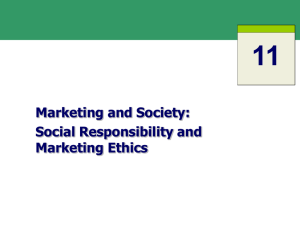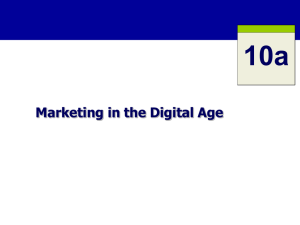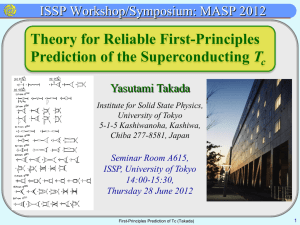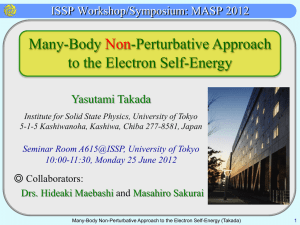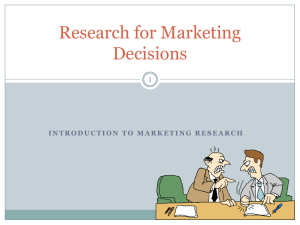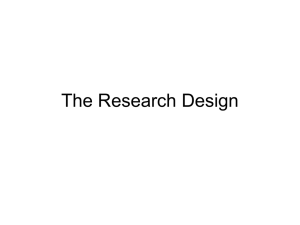Marketing Research
advertisement
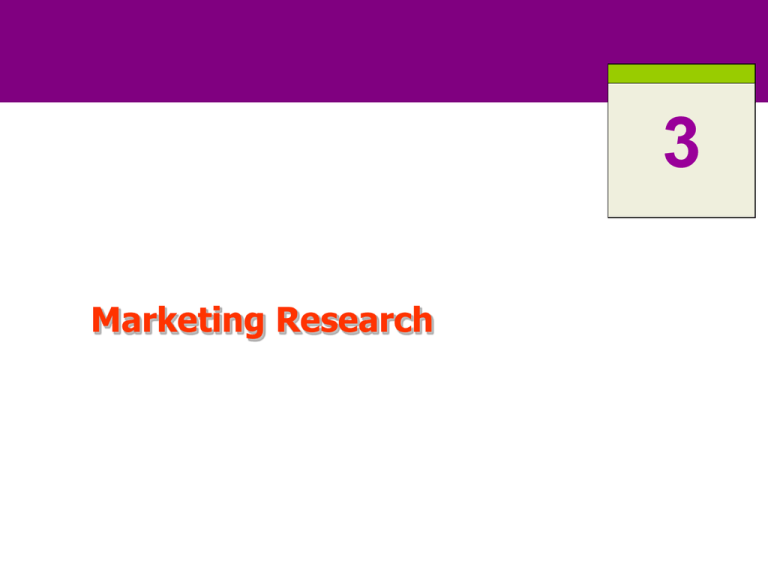
3 Marketing Research ROAD MAP: Previewing the Concepts • Importance of information to the company and its understanding of the marketplace • Marketing information system • Marketing research • How companies analyze and distribute marketing information. • Special issues some marketing researchers face: – public policy and ethics issues. Professor Takada 4-2 ROAD MAP • Importance of information to the company and its understanding of the marketplace • Marketing information system • Marketing research process • How companies analyze and distribute marketing information. • Special issues some marketing researchers face: – public policy and ethics issues. Professor Takada 4-3 The Importance of Information • Companies need information about their: – Customer needs – Marketing environment – Competition • Marketing managers do not need more information, they need better information. Professor Takada 4-4 Information Overload “In this oh so overwhelming information age, it’s all too easy to be buried, burdened, and burned out by data overload.” Professor Takada 4-5 ROAD MAP • Importance of information to the company and its understanding of the marketplace • Marketing information system • Marketing research process • How companies analyze and distribute marketing information. • Special issues some marketing researchers face: – public policy and ethics issues. Professor Takada 4-6 The Marketing Information System Professor Takada 4-7 Marketing Information System • An MIS consists of people, equipment, and procedures to gather, sort, analyze, evaluate, and distribute needed, timely, and accurate information to marketing decision makers. • The MIS helps managers to: 1. Assess Information Needs 2. Develop Needed Information 3. Distribute Information Professor Takada 4-8 Assessing Information Needs • A good MIS balances the information users would like against what they really need and what is feasible to offer. • Sometimes the company cannot provide the needed information because it is not available or due to MIS limitations. • Have to decide whether the benefits of more information are worth the costs. Professor Takada 4-9 Developing Marketing Information • Internal Databases: Electronic collections of • • information obtained from data sources within the company. Marketing Intelligence: Systematic collection and analysis of publicly available information about competitors and developments in the marketing environment. Marketing Research: Systematic design, collection, analysis, and reporting of data relevant to a specific marketing situation facing an organization. Professor Takada 4-10 ROAD MAP • Importance of information to the company and its understanding of the marketplace • Marketing information system • Marketing research • How companies analyze and distribute marketing information. • Special issues some marketing researchers face: – public policy and ethics issues. Professor Takada 4-11 Marketing Research Defined Systematic design, collection, analysis, and reporting of data and findings relevant to a specific marketing situation facing a company. Professor Takada 4-12 The Marketing Research Process 1 2 3 Professor Takada 4 4-13 The Problem Definition and Approach Development Process Tasks Involved Discussions with Decision Makers Interviews with Experts Secondary Data Analysis Qualitative Research Environmental Context of the Problem Step 1: Problem Definition Management Decision Problem Marketing Research Problem Step 2: Approach to the Problem Analytical Framework and Models Research Questions and Hypotheses Step 3:Professor Research Design Takada Specification of Information Needed 4-14 Discussion Between the Researcher and the DM Focus of the DM Focus of the Researcher Symptoms Underlying Causes • Loss of Market Share Discussion • Superior Promotion by Competition • Inadequate Distribution of Company’s Products • Lower Product Quality • Price Undercutting by a Major Competitor Professor Takada 4-15 A Classification of Market Research Designs Research Design Exploratory Research Design Conclusive Research Design Descriptive Research Cross-Sectional Design Causal Research Longitudinal Design Professor Takada 4-16 Marketing Research Designs Exploratory Research Gather preliminary information that will help define the problem and suggest hypotheses. Descriptive Research Describes things (e.g., market potential for a product, Demographics, and attitudes). Causal Research Tests hypotheses about cause-and-effect relationships. Professor Takada 4-17 Some Alternative Research Designs (a) Exploratory Research •Secondary Data Analysis • Focus Groups (b) Conclusive Research •Descriptive/Causal (c) Conclusive Research •Descriptive/Causal Exploratory Research •Secondary Data Analysis •Focus Groups Conclusive Research •Descriptive/Causal Professor Takada 4-18 Focus Group in Session Professor Takada 4-19 Developing the Research Plan • Includes: – Determining the exact information needed – Developing a plan for gathering it efficiently – Presenting the written plan to management • Outlines: – Sources of existing data – Specific research approaches – Contact methods – Sampling plans – Instruments for data collection Professor Takada 4-20 A Classification of Marketing Research Data Marketing Research Data Primary Data Secondary Data Quantitative Data Qualitative Data Descriptive Survey Data Observational and Other Data Professor Takada Causal Experimental Data 4-21 A Classification of Secondary Data Secondary Data Internal Ready to Use Requires Further Processing External Published Materials Syndicated Services Computerized Databases Professor Takada 4-22 Gathering Secondary Data • Information that already exists somewhere – Internal databases – Commercial data services – Government sources • Available more quickly and at a lower cost than primary data • Must be relevant, accurate, current, and impartial Professor Takada 4-23 Primary Data Collection • Consists of information collected for the specific purpose at hand. • Must be relevant, accurate, current, and unbiased. • Must determine: – Research approach – Contact methods – Sampling plan – Research instruments Professor Takada 4-24 Primary Data Collection Research Instruments Questionnaires Mechanical Devices • What questions to ask • Form of each question •Closed-ended •Open-ended • Wording • Ordering • • • • People Meters Supermarket Scanners Galvanometer Eye Cameras Professor Takada 4-25 A Comparison of Primary and Secondary Data __________________________________________________________________________ PRIMARY DATA SECONDARY DATA ________________________________________________________________ Collection purpose For the problem at hand For other problems Collection process Very involved Rapid and easy Collection cost High Relatively low Collection time Long Short ______________________________________________________________________ Professor Takada 4-26 Methods of Obtaining Quantitative Data in Descriptive Research Quantitative Descriptive Research SURVEY Information Obtained by Questioning Respondents Professor Takada OBSERVATION Information Obtained by Observing Behavior or Phenomena 4-27 Survey Research • Most widely used method for primary data collection. • Approach best suited for gathering descriptive information. • Can gather information about people’s knowledge, attitudes, preferences, or buying behavior. Professor Takada 4-28 Strengths & Weaknesses of Contact Methods Professor Takada 4-29 Questionnaire Do’s and Don’ts • Ensure questions are free • of bias • • Make questions simple • • Make questions specific • Avoid jargon • • Avoid sophisticated words • Avoid ambiguous words • Avoid negatives Avoid hypotheticals Avoid words that could be misheard Use mutually exclusive categories Allow for “other” in fixed response questions Professor Takada 4-30 Question Types Dichotomous In arranging this trip, did you contact American Airlines? Yes No Professor Takada 4-31 Question Types – Multiple Choice With whom are you traveling on this trip? No one Spouse Spouse and children Children only Business associates/friends/relatives An organized tour group Professor Takada 4-32 Question Types – Likert Scale Indicate your level of agreement with the following statement: Small airlines generally give better service than large ones. Strongly disagree Disagree Neither agree nor disagree Agree Strongly agree Professor Takada 4-33 Question Types – Semantic Differential American Airlines Large ………………………………...…………….Small Experienced………………….………….Inexperienced Modern………………………..………….Old-fashioned Professor Takada 4-34 Question Types – Importance Scale Airline food service is _____ to me. Extremely important Very important Somewhat important Not very important Not at all important Professor Takada 4-35 Question Types – Rating Scale American Airlines’ food service is _____. Excellent Very good Good Fair Poor Professor Takada 4-36 Question Types – Intention to Buy Scale How likely are you to purchase tickets on American Airlines if in-flight Internet access were available? Definitely buy Probably buy Not sure Probably not buy Definitely not buy Professor Takada 4-37 Question Types – Completely Unstructured What is your opinion of American Airlines? Professor Takada 4-38 Question Types – Word Association What is the first word that comes to your mind when you hear the following? Airline ________________________ American _____________________ Travel ________________________ Professor Takada 4-39 Question Types – Sentence Completion When I choose an airline, the most important consideration in my decision is: ________________________________________ ________________________________________ ________________________________________ ________________________________________ ________________________________________ ________________________________________. Professor Takada 4-40 Question Types – Story Completion “I flew American a few days ago. I noticed that the exterior and interior of the plane had very bright colors. This aroused in me the following thoughts and feelings.” Now complete the story. ________________________________________ ________________________________________ ________________________________________ ________________________________________ ________________________________________ ________________________________________ Professor Takada 4-41 Question Types – Picture (Empty Balloons) Professor Takada 4-42 Question Types – Thematic Apperception Test Make up a story that reflects what you think is happening in this picture. Professor Takada 4-43 Observational Research • The gathering of primary data by observing relevant people, actions, and situations. • Ethnographic research: – Observation in “natural environment” • Mechanical observation: – People meters – Checkout scanners Professor Takada 4-44 Observational Research Fisher-Price set up an observation lab in which it could observe the reactions of little tots to new toys. Professor Takada 4-45 Experimentation as Conclusive Research Conclusive Research Descriptive Causal Experimentation Field Experiments Professor Takada Laboratory Experiments 4-46 Experimental Research • Tries to explain cause-and-effect relationships. • Involves: – selecting matched groups of subjects, – giving different treatments, – controlling unrelated factors, and – checking differences in group responses. Professor Takada 4-47 Choosing the Sample • Requires 3 Decisions: • Sample – segment of the population selected to represent the population as a whole. – Who is to be surveyed? • Sampling unit – How many people should be surveyed? • Sample size – How should the people in the sample be chosen? • Sampling procedure Professor Takada 4-48 Types of Samples Probability • Simple random • Stratified random • Cluster Nonprobability • Convenience • Judgment • Quota Professor Takada 4-49 Implementing the Research Plan Collecting the Data Processing the Data Research Plan Analyzing the Data Professor Takada 4-50 Interpreting & Reporting Findings Managers and researchers must work together when interpreting research results. Step 1. Interpret the Findings Step 2. Draw Conclusions Step 3. Report to Management Professor Takada 4-51 Characteristics of Good Marketing Research Scientific method Research creativity Multiple methods Interdependence Value and cost of information Healthy skepticism Ethical marketing Professor Takada 4-52 Tools to Measure Marketing Plan Performance Sales Analysis Market Share Analysis Expenseto-Sales Analysis Financial Analysis Professor Takada 4-53 Market Share Analysis • Overall market share • Relative market share Professor Takada 4-54 The Control-Chart Model Professor Takada 4-55 Simplified Profit-and-Loss Statement Professor Takada 4-56 The Measures of Market Demand Potential Market Available Market Target Market Penetrated Market Professor Takada 4-57 Ninety Types of Demand Measurement Professor Takada 4-58 Market Demand Functions Professor Takada 4-59 Market Demand Functions Professor Takada 4-60 Estimating Current Demand • Total market potential • Area market potential – Market buildup method – Multiple-factor index method • Brand development index Professor Takada 4-61 Calculating Brand Development Index Professor Takada 4-62 Estimating Future Demand • Survey of Buyers’ Intentions • Composite of Sales Force Opinions • Expert Opinion • Past-Sales Analysis • Market-Test Method Professor Takada 4-63 Purchase Probability Scale Do you intend to buy an automobile within the next 6 months? 0.00 No 0.20 Slight possibility 0.40 Fair possibility 0.60 Good possibility 0.80 High possibility 1.00 Certain Professor Takada 4-64 ROAD MAP • Importance of information to the company and its understanding of the marketplace • Marketing information system • Marketing research process • How companies analyze and distribute marketing information. • Special issues some marketing researchers face: – public policy and ethics issues. Professor Takada 4-65 Customer Relationship Management • Many companies utilize CRM – Capture customer information from all sources – Analyze it in depth – Apply the results to build stronger relationships. • Companies look for customer touch points. • CRM analysts develop data warehouses and use data mining techniques to find information out about customers. Professor Takada 4-66 Distributing and Using Marketing Information Routine Information for Nonroutine Information for Special Situations Decision Making Information Must be Distributed to the Right People at the Right Time Intranets Extranets Professor Takada 4-67 ROAD MAP: Previewing the Concepts • Importance of information to the company and its understanding of the marketplace • Marketing information system • Marketing research process • How companies analyze and distribute marketing information. • Special issues some marketing researchers face: – public policy and ethics issues. Professor Takada 4-68 Other Marketing Research Considerations Marketing Research in Small Businesses and Nonprofit Organizations International Marketing Research Public Policy and Ethics in Marketing Research Professor Takada 4-69 Research Services Roper ASW, Inc. provides companies with information resources “from Brazil to Eastern Europe; from Cape Town to Beijing— if you are there, Roper ASW, Inc. is there.” Click Here to Visit RoperASW Professor Takada 4-70 Top 25 Global Research Organizations 2000 1 2 3 4 5 6 7 8 9 10 11 12 13 14 15 16 17 18 19 20 21 22 23 24 25 1999 1 2 3 4 5 — 6 8 10 11 9 14 12 15 13 16 18 17 19 20 — 21 25 — — Organization AC Nielsen Corp. IMS Health Inc. The Kantar Group Taylor Nelson Sofres plc Information Resources Inc. VNU Inc. NFO WorldGroup Inc. GfK Group Ipsos Group SA Westat Inc. NOP World Aegis Research Arbitron Inc. Video Research Ltd. Maritz Research The NPD Group Inc. Opinion Research Corp. INTAGE Inc. J.D. Power and Associates Roper Starch Worldwide Inc. Jupiter Media Metrix Inc. Dentsu Research Inc. IBOPE Group Harris Interactive Inc. MORPACE International Inc. Headquarters Stamford, Conn. Westport, Conn. Fairfield, Conn. London Chicago New York Greenwich, Conn. Nuremberg Paris Rockville, Md. London London New York Tokyo St. Louis Port Washington, N.Y. Princeton, N.J. Tokyo Agoura Hills, Calif. Harrison, N.Y. New York Tokyo Rio de Janeiro Rochester, N.Y. Farmington Hills, Mich. Parent company U.S. U.S. U.K. U.K. U.S. U.S. U.S. Germany France U.S. U.K. U.K. U.S. Japan U.S. U.S. U.S. Japan U.S. U.S. U.S. Japan Brazil U.S. U.S. Total Global research Revenues1 (US$ millions) $1,577.0 1,131.2 928.5 709.6 531.9 526.9 470.5 444.0 304.2 264.4 246.1 232.2 206.8 174.3* 172.0 164.3 123.9 119.3* 104.0 73.9 69.1 67.6 60.7 56.0 54.3 Percent of global revenues from outside home country 67.0% 62.5 71.4 75.2 25.0 2.6 62.4 62.4 78.3 0.0 60.0 32.2 3.4 0.0 31.5 17.0 28.9 1.8* 15.4 14.3 15.0 0.3 31.8 5.4 26.1 $8,812.7 49.3% 1 Total revenues that include nonresearch activities for some companies are significantly higher. * For fiscal year ending March 31, 2001. Professor Takada 4-71 A Sample of Marketing Research Jobs Professor Takada 4-72 Rest Stop: Reviewing the Concepts • Explain the importance of information to the • • • • company. Define the marketing information system and discuss its parts. Outline the steps in the marketing research process. Explain how companies analyze and distribute marketing information. Discuss the special issues some marketing researchers face, including public policy and ethics issues. Professor Takada 4-73
